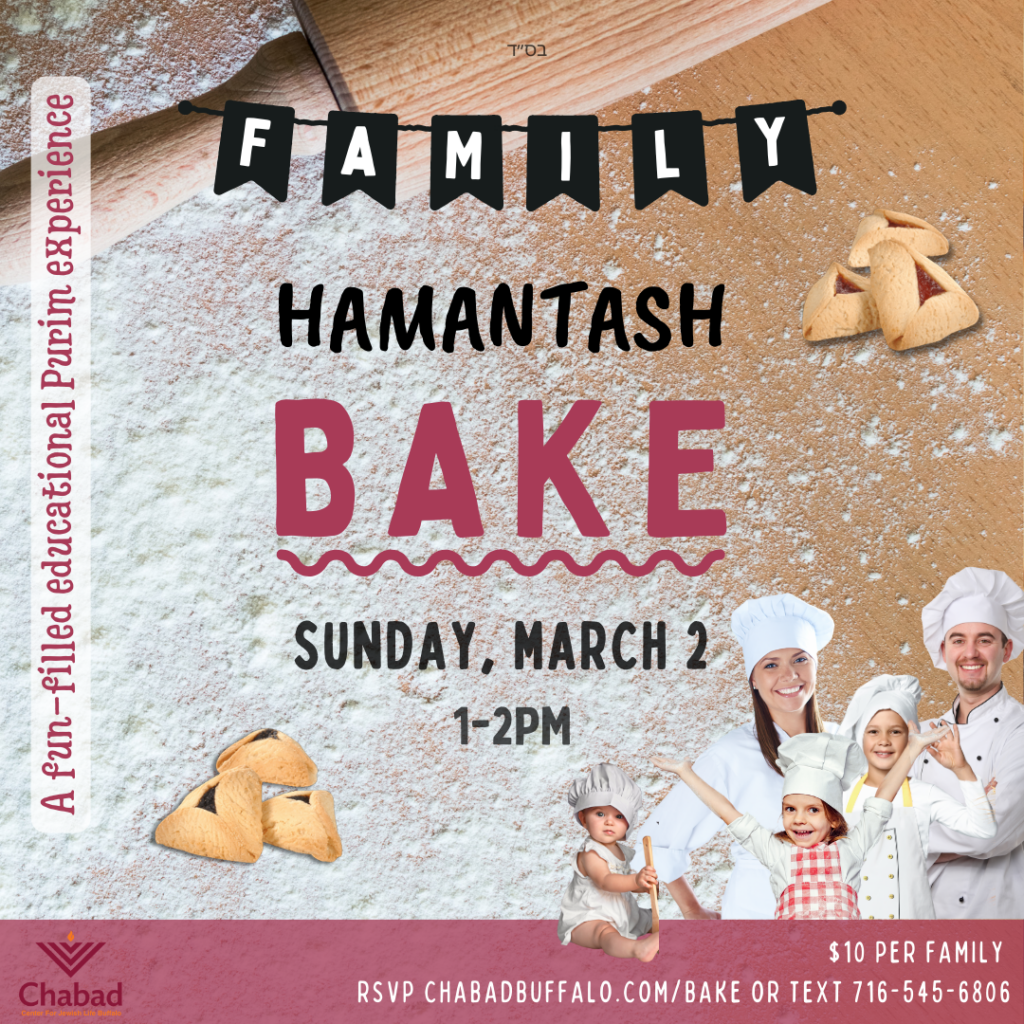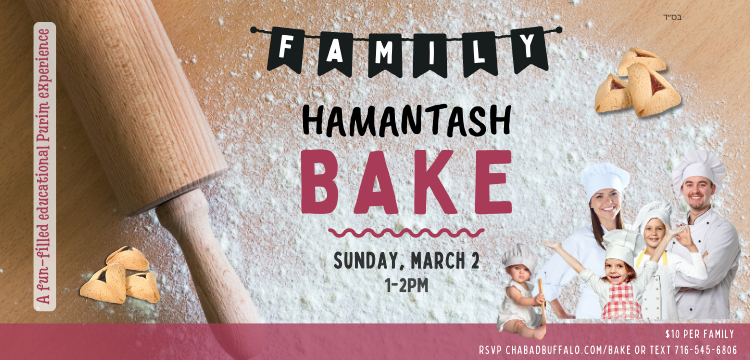
Family Hamantash Bake! 🎭🥟
Join the Chabad Center for Jewish Life of Buffalo for a fun and interactive Family Hamantash Bake as we get into the Purim spirit!
📅 Date: March 2nd, 2025
📍 Location: Provided upon registration
⏰ Time: 1pm – 2pm
💲 Cost: $10 per family
Bring the whole family for a hands-on Hamantash baking experience! Learn the secret to making these delicious, triangular Purim treats, enjoy a festive atmosphere, and take home your homemade goodies.
🔹 Dough, fillings & toppings provided
🔹 Fun for all ages!
🔹 Purim music & storytelling
🔹 Learn the meaning behind Hamantashen
👨👩👧👦 All are welcome – no prior baking experience needed!
Get ready for a sweet and meaningful pre-Purim celebration! 🥳
What Is Purim?
The jolly Jewish holiday of Purim is celebrated every year on the 14th of the Hebrew month of Adar (late winter/early spring). Purim 2025 begins on Thursday night, March 13 and continues through Shabbat, March 14 (extending through Sunday in Jerusalem). It commemorates the (Divinely orchestrated) salvation of the Jewish people in the ancient Persian empire from Haman’s plot “to destroy, kill and annihilate all the Jews, young and old, infants and women, in a single day.” Literally “lots” in ancient Persian, Purim was thus named since Haman had thrown lots to determine when he would carry out his diabolical scheme, as recorded in the Megillah (book of Esther).
What is the Purim story in a nutshell?
The Persian Empire of the 4th century BCE extended over 127 lands, and all the Jews were its subjects. When King Ahasuerus had his wife, Queen Vashti, executed for failing to follow his orders, he arranged a beauty pageant to find a new queen. A Jewish girl, Esther, found favor in his eyes and became the new queen, though she refused to divulge her nationality.
Meanwhile, the Jew-hating Haman was appointed prime minister of the empire. Mordechai, the leader of the Jews (and Esther’s cousin), defied the king’s orders and refused to bow to Haman. Haman was incensed, and he convinced the king to issue a decree ordering the extermination of all the Jews on the 13th of Adar, a date chosen by a lottery Haman made.
Mordechai galvanized all the Jews, convincing them to repent, fast and pray to G‑d. Meanwhile, Esther asked the king and Haman to join her for a feast. At a subsequent feast, Esther revealed to the king her Jewish identity. Haman was hanged, Mordechai was appointed prime minister in his stead, and a new decree was issued, granting the Jews the right to defend themselves against their enemies.
On the 13th of Adar, the Jews mobilized and killed many of their enemies. On the 14th of Adar, they rested and celebrated. In the capital city of Shushan, they took one more day to finish the job.
Why is it called Purim?
Purim means “lots” in ancient Persian. The holiday was thus named since Haman had thrown lots to determine when he would carry out his diabolical scheme. You can pronounce this name many ways. In Eastern tradition, it is called poo-REEM. Among Westerners, it is often called PUH-rim. Some Central-European communities even call it PEE-rim. (WARNING: Calling this holiday PYOO-rim—as English speakers are sometimes wont to do—is a surefire newbie cover-blower.)
What are Purim observances?
- Reading of the Megillah (book of Esther), which recounts the story of the Purim miracle. This is done once on the eve of Purim and then again on the following day.
- Giving money gifts to at least two poor people.
- Sending gifts of two kinds of food to at least one person.
- A festive Purim feast, which often includes wine or other intoxicating beverages.

